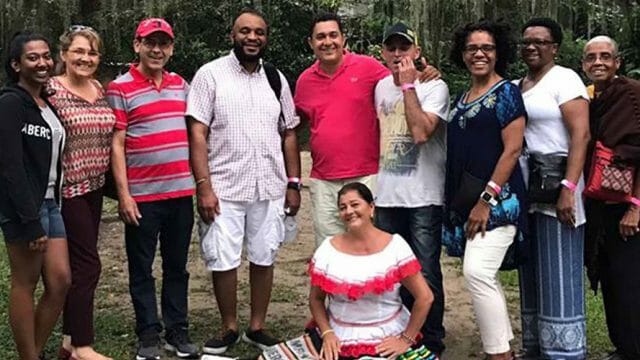InVerse combines the Sabbath School lesson with topics specifically for young adults.

What has happened to Sabbath School in the Adventist Church?
“Sabbath School, in general, seems to be languishing in the Global North [formerly called ‘First World,’]” Justin Kim, assistant director for Sabbath School and Personal Ministries at the General Conference of Seventh-day Adventists and young adult Sabbath School Bible study guide editor, said. “The question of the century is: Why? There are a lot of theories out there, but we don’t exactly know why attendance numbers are dropping.”
In the developed world, approximately 50 percent of the Adventist membership attends church regularly, and roughly 50 percent of that number attend Sabbath School. As with Sunday schools, the decline began in the 1970s, parallel to the countercultural movement and a growing distrust of institutions. In the 1980s, the rise of megachurches emphasized big worship experiences and the main church service. Even though the 1990s saw a resurgence of small groups, the focus wasn’t on Sabbath School groups but Friday night or after-church gatherings of young people.
“What we do know,” Kim said, “is that young adults have — at least for the last 50 years or so — been disinterested in Sabbath School. We also know that InVerse is reversing this trend somewhat in parts of the Global North.”
InVerse is the new, updated, and refreshed Collegiate Quarterly (CQ). While InVerse kept some aspects of CQ — like the social part of communicating about and discussing the Bible — much of it is revamped. Whereas CQ was a devotional commentary on the Adult Bible Study Guide, InVerse has far fewer fill-in-the-blank sections and many more in-depth prompts to look at scriptural themes and language.
Each year, two quarters of InVerse follow the regular adult Sabbath School lesson. The other two quarters focus on topics specifically relevant to young adults, such as the basics of salvation, sexuality, the purpose of education, young adult principles of stewardship, Sabbath issues for professionals, and how to know God’s will for one’s life.
“Since the shift in 2019, the global response has been very positive,” Kim said. “Divisions and unions are continuing to translate InVerse into new languages, but in areas where translation is slower, young adult church members are translating it for themselves and distributing the study guide through social media and messaging apps.”
It’s important to note that the term “young adult” is a flexible one. Though typically defined as ages 18 to 35, Kim said, anyone interested in the content is welcome to utilize InVerse Bible study guides.
Unlike many ministries, InVerse benefitted from the pandemic. Friends couldn’t get together, but people were craving community and spiritual engagement. InVerse filled both of those needs, Kim said, spreading around the world by word of mouth by those who had started their small online groups and told others how valuable it was, and allowing small groups to form across international borders — something that hadn’t been done before.
“Young adults have particular spiritual needs that are different from those who have more experience in their walk with God,” Kim said. “They’re trying to figure out how to raise their kids, what to do with their money, how to navigate society — sexuality, politics, career — what to look for in a life partner, and so many others. These are not some of the questions foremost in other study guides. InVerse attempts to address these topics openly, based on Scripture.”
Each part of InVerse is split into seven sections, corresponding with the days of the week, each with its activity taking the reader deeper into the Word. These activities include writing out a passage of Scripture by hand, examining the passage to find patterns, using the passage to revive one’s relationship with God, cross-referencing additional Bible verses, gaining insight from related excerpts of the writings of Ellen G. White, and discussion questions.
“It’s intense,” Kim admitted. “Those who engage with InVerse say it’s so different from what they’re used to, and they love it. The great thing is that they get excited about it and want to share it with others. It’s the Bible, and they want to talk about it. It’s natural and organic witnessing.”
Kim admitted that some of the topics InVerse addresses — such as biblical sexuality — have made a few members hesitant, but the overall response has been positive.
“People tell us they see God in a totally different way after studying this topic from a biblical perspective using the InVerse method,” he explained. “Some admit that it still feels a bit awkward to talk about sexuality at church, but in the same breath, they thank us for addressing it because it’s not something the church has historically done, and there’s a need and a desire for it.”
Another aspect that sets InVerse apart from other study guides is that, rather than being entirely digital or entirely in print, InVerse is a blend of both. It’s not an either/or scenario, Kim said; it combines both approaches and allows the user to determine how much of each they want to incorporate into their study.
In addition to the printed study guide, InVerse can be found on the new official Sabbath School mobile app and has a television show (previously known as Sabbath School University) produced by Hope Channel. The weekly production can be used as preparation for study or as an extension of the small group discussion.
“Interaction with peers is a hugely important part of life for young adults,” Kim pointed out. “So the social aspect has to be baked into the study guide. It’s working really well in Europe, South America, and Australia, and they have produced a lot of accompanying material for InVerse. Everyone is trying to keep young people in the church, and they’re being creative about it.”
Kim shared a story about a young person on the verge of walking away from the church when their local Sabbath School group invited them to an InVerse group study. A small group that was about to disband had decided to try InVerse in early 2020. A year and a half later, they’re a thriving small group that meets regularly.
“They were excited to learn about Jesus in the text, and not just doctrinal exposition,” Kim said. “We want to see what’s in the verse, but it’s also about finding an inverse way of thinking and looking at things from a different angle.”
While doctrine remains crucial to the church, Jesus is the one whom doctrine points to. Doctrine, Kim pointed out, is a theological construct to help us make sense of the Bible. And if anyone truly studies the Bible with an open mind, Kim believes, they’ll come naturally to Adventist doctrines. But though these doctrines are used to clarify, they are not the primary goal.
“Our church was founded by young people studying the Word,” Kim said. “They sat down and studied the Bible together. Social reinforcement is necessary because the Holy Spirit works with community environments, and dialogue helps clarify interpretation, understanding, and application.”
The original version of this story was posted by Adventist News Network.








